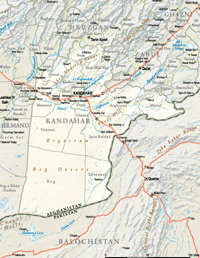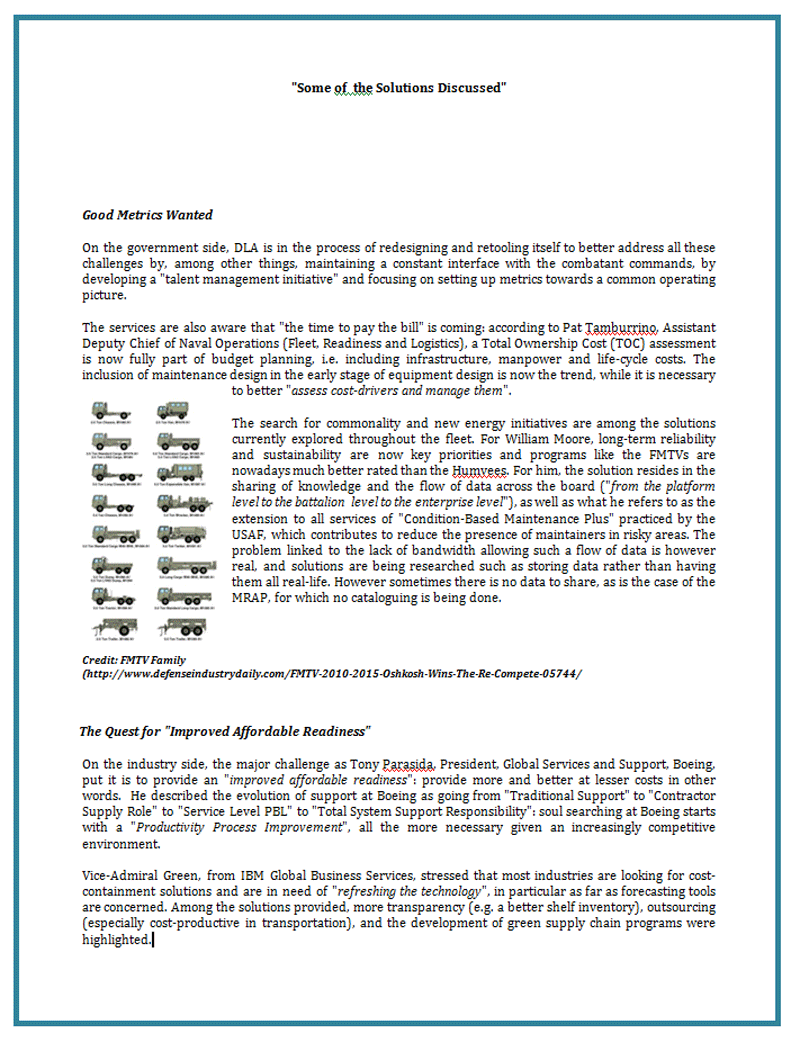With the announcement of President Obama’s Surge policy in Afghanistan and the addition of 30,000 extra-troops in a six-month framework, a key question was on the lips of many participants of Defense Logistics, the annual cross-service Logistics conference organized by Worldwide Business Research in Arlington, Virginia from November 30th to December 3rd: “how are we going to keep providing the equipment the troops will need once in the Afghan theater?”
Reinforcement has just been done in the past months, as one participant pointed out, without affecting the requirement for a smaller logistic footprint: “there has only been one sustainment brigade, assuming a support role to supporting units, in Afghanistan from the outset, even when additional troops came in“, recalled William Moore, Deputy Commander, Combined Arms Support Command, US Army.
But the current double-dare of “Plus Up Afghanistan” and “a responsible withdrawal from Iraq” poses huge challenges “, underscored Vice-Admiral Thompson, director of the Defense Logistics Agency (DLA) since 2008. These challenges and the solutions both the government and industry are trying to meet was a significant focus of the conference.
Challenges In the Theater
The challenges on the field are linked to the traditional hardship of fighting a war in Afghanistan, while withdrawing from another major theater of operation. Among the key challenges are the issues of accessibility, the scarcity of forward operating bases and the strategic character of Kandahar and the complexity of the reset and retrograde process.
- The issue of accessibility
So far, according to Vice-Admiral Thompson, US troops are in “good shape” as far as the sustainability of supplies has been concerned. He mentioned in particular the fuel supply as a major ” readiness enabler ” and a real “success story”: even though it is trucked via mountainous and perilous areas, the services’ biggest consumer, the USAF, has always been in a position to conduct its missions.The DLA Director also cited as another example the current high tempo of monthly deliveries of 500 MATVs to Afghanistan, with Oshkosh building 1,000 a month. A well-known challenge compared to Iraq is however the nature of the land-locked terrain in Afghanistan, which makes it hard to deliver “the right equipment at the right time.” Air delivery (including via the crucial help of commercial airplanes) and ground roads through Pakistan should soon however be completed by a Northern Distribution network currently under negotiation. Other factors complicate access, such as according to Admiral Thompson, “poor infrastructure, landmines which the Soviets had set all over the country, mostly dirt roads, etc“.

- The scarcity of forward bases and the strategic character of Kandahar
The United States is primarily using Kuwait and Kandahar facilities as their major hubs to re-supply the troops, but with 30,000 troops more in the pipeline along with allied troops, an already crowded Kandahar could be saturated at a time when ISAF and the Talibans seem to be at a stalemate in the area. According to a study released this month by the Washington-based Institute for the Study of War, which describes how the Talibans have gradually taken hold of the surrounding cities since 2004, a victory in Kandahar will be the turning point for total control of the country, one of the reason being that most major access roads go through it.
The Defense Logistics Agency has anticipated the expansion by building a facility in Southern Kandahar for re-supply, as well as to “dispose of unneeded equipment“, explained Vice-Admiral Thompson, but the process is slow, given the landmines military units have to take out one at a time. Land mines surround the airbase from Soviet times.
- The complexity of the reset and retrograde process
Everyone knows what a massive and costly job withdrawing U.S. military equipment from Iraq is proving to be but the level of complexity of the decisions needed to be made on a case-by-case manner is sometimes overlooked. Indeed even though some guidelines have been set, key questions remain about what to do with each item and where it should be sent to. One panelist from a discussion on the “Retrograde and Reset Challenges” panel described the multitude of options available and the remaining question marks for some of the supply: whether “it stays in the units, goes from OIF to OEF, whether it is a field maintenance, or if it needs to be reset and configured for Afghanistan“, then the next question is where do you put it? And if it is a CONUS reset, do you decide to reconfigure it to its current capability? What do you do with non-standard equipment? What about military sales?” The surge brings about another set of factors to enter into the equation, as, as one officer put it, “there might not be much retrograde left after all.” While for Colonel James Vohr, Director of Logistics, US Southern Command, reconstitution is the goal and not so much reset. The key point is that the US is not simply seeking to warehouse returned equipment but take key items and make them combat ready. i.e. “restoring units to combat effectiveness, or upgrading them to full-spectrum capacity.”
Challenges In CONUS
- The Impact of the current acquisition shift
Given the current acquisition trends, the days for new equipment and thorough upgrades are gone. Warfighters must do with what they have and what they have is getting in many cases rather ragged as the wear and tire is making itself increasingly felt on current equipment. For USMC General Ruack, the toll is already being felt on the homefront in terms of training, while equipment is being redlined. The troops are “digging in on them“, the risk being to go “down to our waistline“. Till now the armed forces benefited from a lot of new equipment and the ratio between reset and field maintenance was roughly 90%/10%: “such a ratio is very likely to shift with 1/3rd procurement, 1/3rd depot and 1/3rd remaining at the field level or not being replaced“. Colonel Vohr also expressed concerns about the dynamic tensions between buying aging equipment and acquiring new ones. For him, the upcoming challenges are the OIF/OEF transition in the context of high equipment degradation rates and a faster use of ground equipment.
-
The unpredictability factor: the case of the Depots
One of the issues is what is going on at the depot level “where the rubber meets the road” as Dr John Gray, deputy Commander, Letterkenny Army Depot, put it, describing his task as a challenging one. The major difficulty for the depots is what he described as the “lack of predictability.” This lack of predictability is three-fold:
1. The unknown factor: the work-load expectations: No one knows how many pieces of what equipment will be needed ahead of time, since no one knows in advance in what condition it is going to show up to be put back into their initial condition. This makes it impossible for the depots not only to know what they need, but above-all to have some kind of cost-productive series effect, with the notable exception of the Humvees Recap which were fixed in large number and rapidly operational (4,000 a year).
2. The unpredictability factor is financial, since reset money when it started in 2004 mostly came from Supplementals. These are gone, while Dr. Gray’s budgetary forecast points out at a 30 to 50 % decrease in funding with a major plunge coming up in 2012.
3. The availability of spare parts challenge: Dr. Gray spends his entire days looking for these missing parts; he indeed points out that even though DLA is providing about 92% of them, it is always these 8% which will be driving everyone crazy and of course slow down the process and make it even less predictable, no matter how efficient the reset process can be. His regret, he concluded humorously, is that Loewe’s does not build these parts, since for military equipment, each spare part is often unique and specific and that “99% of the parts is 100% failure”.
For the warfighters on the field, the biggest challenge comes from the apparent absence of a reconstitution strategy, “a major strategic risk being taken while the country has been at war for almost ten years“, concluded one of the participant. Resetting the force is in other words “a tough balancing act” in perspective, as General Ruack described it.
———-
***Posted December 7th, 2009



